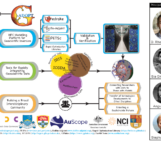
Interdisciplinary research are the buzzwords all funding agencies want to hear these days. After reading my blog on how to write an interdisciplinary proposal researching the interior of planets, Ruby decided to approach a geochemistry group to collaborate. They have kindly invited her to present her latest research at their group meeting, which left Ruby coming to ME for help:
How should I prepare a talk for a geochemistry group meeting as a geodynamicist?
Dear Ruby,
You are brave to venture yourself outside the safe and comfortable world of geodynamics. I am glad you are taking my advice and you intend to pursue more interdisciplinary research.
I suggest a pretty photo on your first slide. And second. And last. We both know that there will be only equations in the middle of your talk, so try to grasp the audience with a pretty picture from the beginning. I recommend a photo from a big outcrop, with beautiful folds and blue skies, despite that you have never actually ventured more than 2 meters away from your laptop (you can steal some pretty photos of sheared rocks from here). The rest of the intro slides could be sprinkled with cartoons of planetary models or figures of mantle dynamics simulations from your archenemies favourite papers.
Of course most of your slides will have equations spanning two or three alphabets. No numbers! Numbers are bad! Include only letters and squiggles. Make sure to include every.single.equation. Do not worry about annotating variables or terms with different boxes, colours, or arrows. Of course everyone knows what Re, Ra, Pr, Kn, M, Ar, Ek, Pr, Nu and Pe numbers stand for! You must have the slide with conservation equations: no one who has done a geology degree in the past 50 years has come across them in their course and career. Then you have to make sure you are explaining in detail the governing equations, while skipping over the flow laws you use, because who cares?! It’s all diffusion creep anyway.
The real slides to over-emphasize are the complex processes you and only you managed to approximate and code into your fancy numerical models. Meticulously go through all the libraries you used and the parallel computing you deployed. They don’t need to know the details of how you verified and benchmarked your code. Everyone should just trust you that things work. You show them pretty pictures of simulations in rainbow colours after all!
Finally, it is upon your audience to think how your precious models fit with their observations. That’s on them, not you! You can happily finish your presentation now.
Remember! Never simplify your models and thinking. Nature is complex, after all!
Yours truly,
The Sassy Scientist
PS: Do not forget to mention the potential to use machine learning at the end!




